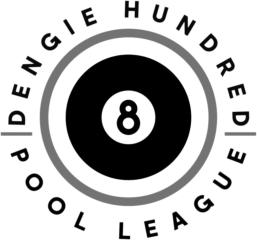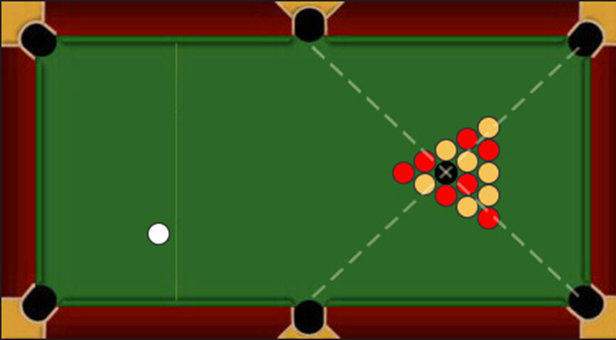

@ DHPL 2025
RULES 2025>2026
NOTE: The only difference is retaining the ‘Nomination’ of the Black Ball Pocket ..
These are the Rules by which the DHPL play.
Blackball Pool Rules
This is a summary of World Pool Association Blackball Pool Rules.
Objective of the Game
Blackball is played with 15 coloured object balls and a cu e ball.
The object balls consist of two groups of seven and the black ball.
Mostly the group balls comprise one group of reds and another of yellows.
(Less often balls are coloured blue and yellow)
The black ball may sometimes be referred to as the eightball.
The player or team potting their own group of object balls and legally potting the black wins the game.
Players do not need to nominate any of the shots they are about to play in blackball pool.
Terms Used
The table is comprised of rails, cushions, pockets and the playing surface.
The foot end of the table is where the object balls are placed at the start of a game.
The head end is where the cue ball is positioned when play is about to begin.
The cushions and pockets are considered parts of the head, foot and side rails.
The baulk line is parallel to the head rail. It is drawn one fifth of the length of the playing surface away
from the head cushion.
Baulk is the rectangular area bordered by the baulk line and the three cushions at the head of the table.
The head cushion is often referred to as the baulk cushion.
After an illegal or foul shot is played an incoming opponent is given a free shot. That free shot may be
played either from the existing position of the cue ball on the table, or from baulk.
An object ball is said to be on when it is legally playable.
A player is snookered when the cue ball cannot take a straight path to hit at least part of a target ball.
Snookers must be declared as such by a referee (or mutually agreed by both players)
Lag and Break
Play begins when a break shot is played from baulk.
However, before breaking, it is necessary to determine which player executes the first break shot of a
match.
It is the player winning the lag who will decide which player breaks.
Prior to lagging a ball is placed on each side of baulk adjacent to, but not touching, the side cushions.
The objective of opposing players is to play their ball to strike the opposite foot cushion before
returning and coming to rest as close as possible to the baulk cushion.
The lag winner is the player whose ball comes closest to that baulk cushion.
A player may lose the lag if, for example, his or her ball strikes a side cushion or drops into a pocket.
The Rules of Breaking
The cue ball begins in hand.
That means it can be placed by the breaking player anywhere within the baulk area.
On breaking at least one group ball must be potted or two object balls cross the centre string, that is a
line joining the two centre pockets.
When two object balls fail to cross that line, and no group balls are potted, a standard foul is declared.
If the cue ball is potted or driven off the table, then that to is a foul.
More about fouls and their consequences in blackball pool will follow.
Any fouls on the break are ignored if the black ball is potted, iIf that happens the object balls are always
racked again and the same player breaks.
Determining Groups
In this game players do not nominate their group of object balls.
At the start of a frame, before players’ groups have been determined, the table is said to be open.
The table is open after the break and remains open until a player pots a ball or balls from only one
group in a normal legal shot.
The ball potted decides the group of that player. However, groups are not assigned if balls from both
groups are potted on a shot, or on a free shot following a foul.
Continuing Play
A player remains at the table while continuing to play legal shots, or until the frame ends.
If a player does not pot any ball on a shot and no foul has been committed the incoming player plays
the cue ball from its current position.
If a player commits a standard foul, play passes to the opposition.
The incoming player then takes a free shot before continuing with his or her visit to the table in the
normal way. That is provided of course the player does not commit a foul in the course of taking that
free shot.
In taking a free shot an incoming player may play the cue ball from the existing position on the table or
choose
to have the cue ball in hand. In which case the player plays the free shot from baulk.
When taking that free shot a player may, if he or she wishes, first strike or pot a ball or balls from the
opponent’s group. On a free shot these are not considered fouls.
After a free shot play continues with a normal visit to the table.
Standard Fouls
There is a number of so-called standard fouls in the game of blackball.
This term distinguishes them from fouls which lead to the automatic loss of a frame.
All standard fouls result in the incoming player receiving a free shot on the 1st of 2 shots, subsequently,
if the player pots a ball on their free shot (their own or their opponents) they only have 1 shot
remaining (the 2 shots do not carry forward) should they not pot they have 1 shot remaining.
On playing a normal shot, it is a standard foul when an opponent’s group ball is struck first or if only an
opponent’s group ball is potted.
However, such play is not considered a foul if a player is taking a free shot, when playing a free shot,
after a foul has been awarded, a player may first strike or even pot a ball or balls
from an opponent’s group.
During normal play, or when taking a free shot, it is a standard foul when....
● No balls contact a cushion after the cue ball strikes an object ball. That is unless an object ball is
legally potted on that same shot. The exception to this rule is in attempting to escape a snooker. It is
not then necessary to strike a cushion when a shot is played. Of course, if a player fails to escape a
snooker it is a foul.
● The cue ball is potted, or any balls leave the pool table. They must be returned to the table and
placed in accordance with official blackball rules before play continues.
● A player does not have a foot on the floor when the cue tip contacts the cue ball.
● Touching or moving the cue ball by hand. The exceptions being that the cue ball may be moved by
hand prior to breaking or on a free shot when positioning the cue ball in baulk.
● A ball is accidentally touched during the course of a game by chalk, bridges or, for example, a
player's hair or clothing.
● The cue tip contacts the cue ball more than once on a single shot.
● The cue tip is still touching the cue ball when the cue ball contacts an object ball.
● Tip to ball contact is prolonged beyond that seen in a normal shot. That constitutes a push shot.
● A shot is played while any balls are moving.
● A player unintentionally takes a shot out of turn.
Combination Shots
In considering standard fouls it is important to understand the concept of a combination shot.
In normal continuing play, that is when not playing a free shot, a player may strike an object ball from
his or her own group and then go on to legally pot balls from both groups in that same shot.
Note, the object ball struck first must be a player's own group ball, unless a free shot has been awarded.
When balls from both groups are potted in combination, it does not matter which balls fall into pockets
first.
Combination shots can also be played involving the black ball. Of course, on playing a shot in which the
black is potted in combination with any other object ball, the frame is won only if no balls from a
player’s own group remain on the table, otherwise it’s loss of frame.
The term skill shot is also used to describe combinations.
Touching Ball
When a player plays a cue ball away from a touching object ball that cue ball is considered to have
struck that object ball.
One consequence of this is that the cue ball need not subsequently contact another object ball when
executing the shot. Though of course the other requirements of a legal shot must be met, such as
striking a cushion.
It also follows that in playing away from a touching ball from his or her own group, the cue ball may
then legally proceed to hit an opponent’s group ball. This is possible because the player is deemed to
have first struck the touching object ball from his or her own group.
Loss Of Frame
Under certain circumstances a player may automatically lose the frame.
This happens when a player....
● Pots the black ball on an illegal shot. For example on a push shot.
● Pots the black on a shot that leaves any of his or her group balls on the table.
● Intentionally strikes a ball which is not an ‘on’ ball.
● Deliberately touches or picks up a ball when not entitled to do so.
● Does not attempt to hit an ‘on’ ball.
Stalemate
In some games a situation may occur when no legal shot is playable.
Whether this happens by accident or design it is a stalemate, and the frame is restarted.
The referee (or both players / captains) will decide whether a legal shot is possible.
The original breaking player breaks again if a stalemate has been called.
Winning the Frame
The player must pot the Black (8) Ball and must nominate the pocket.
Unsportsmanlike Conduct
Players should be made aware that penalties will be imposed for conduct considered unsportsmanlike.
The referee (or Captains) might issue a warning, call a standard foul, declare loss of frame, or the loss
of a match.
Unsportsmanlike conduct is any intentional behaviour that brings the sport into disrepute, or which
disrupts the game to such an extent that fair play is affected.
Such behaviour might include distracting an opponent, intentionally miscuing, marking the table,
using equipment inappropriately or playing under the influence of drink or drugs.
This kind of conduct could result in the forfeiture of frame, match and competition points.

A4 Format
A3 Format













